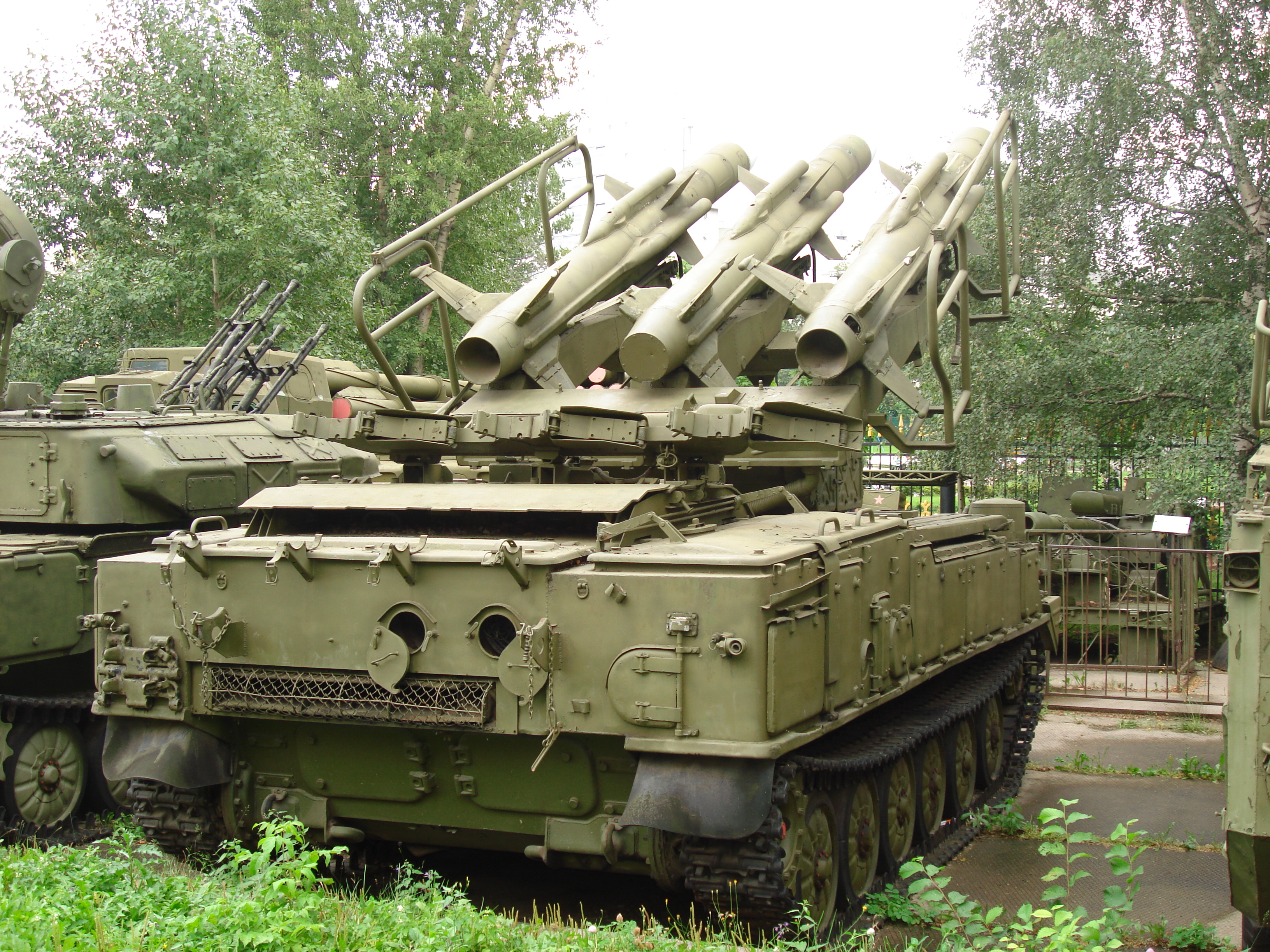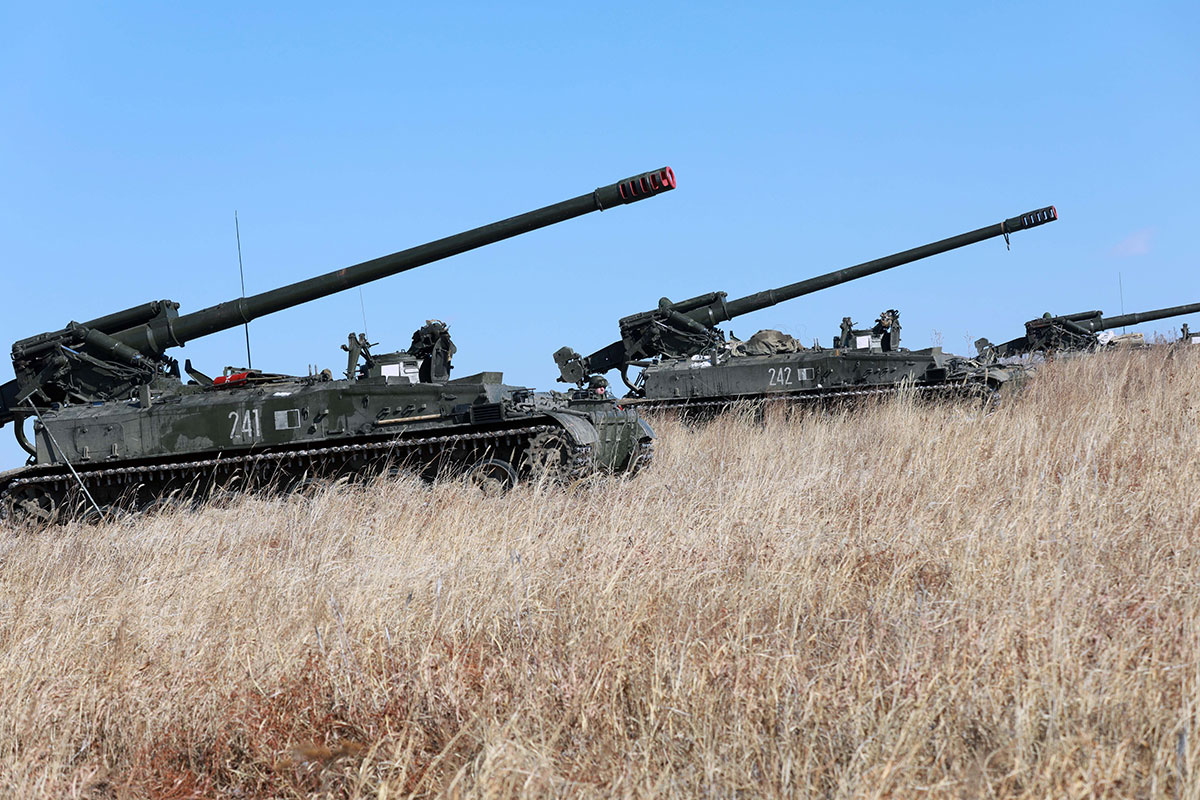|
GM Chassis
(Russian: ''Gusenichnaya Mashina'', ''Гусеничная машина'', lit. ''tracked machine'') is a series of tracked vehicle chassis. Generally, the series is produced by Russia's '' Mytishchi Machine-Building Plant''. Some older series were developed and produced by Belarusian agriculture machinery manufacturer Minsk Tractor Works (MTZ). GM-569 GM-569 is used for the TELAR 9A38, part of the Buk-M1-2 SAM system. Specifications * Chassis weight: 24,000 kg * Max load: 11,500 kg * Wheelbase: 4,605 mm * Ground clearance: 450 mm * Fuel distance: 500 km * Working environment ** outside temperature: −50°C — +50°C ** relative air humidity: 98% (t = +35 °C) ** overall dust level while driving < 2,5 g/m3 * Max velocity: 65 km/h * Average ground unit pressure < 0,8 kg/cm2 * Engine type: Multifuel liquid-cooled diesel * On-board powerplant: 522 kW (710 h.p.) — 618 kW (840 h.p.) Other type ...
|
2K12 Kub
The 2K12 ''"Kub"'' (; English: 'cube') (NATO reporting name: SA-6 "Gainful") mobile surface-to-air missile system is a Soviet Union, Soviet low to medium-level air defence system designed to protect ground forces from air attack. ''2К12'' is the GRAU designation of the system. Each 2K12 battery consists of a number of similar tracked vehicles, one of which carries the 1S91 (SURN vehicle, NATO designation "Straight Flush") 25 kW G band (NATO), G/H band (NATO), H band radar (with a range of ) equipped with a continuous wave semi active radar homing, illuminator, in addition to an optical sight. The battery usually also includes four triple-missile transporter erector launchers (TELs), and four trucks, each carrying three spare missiles and a crane. The TEL is based on a GM chassis, GM-578 chassis, while the 1S91 radar vehicle is based on a GM-568 chassis, all developed and produced by Russian manufacturer Mytishchi Machine-Building Plant, MMZ. Development The development ... [...More Info...] [...Related Items...] OR: [Wikipedia] [Google] [Baidu] |
Military Vehicles Of Russia
A military, also known collectively as armed forces, is a heavily armed, highly organized force primarily intended for warfare. Militaries are typically authorized and maintained by a sovereign state, with their members identifiable by a distinct military uniform. They may consist of one or more military branches such as an army, navy, air force, space force, marines, or coast guard. The main task of a military is usually defined as defence of their state and its interests against external armed threats. In broad usage, the terms "armed forces" and "military" are often synonymous, although in technical usage a distinction is sometimes made in which a country's armed forces may include other paramilitary forces such as armed police. Beyond warfare, the military may be employed in additional sanctioned and non-sanctioned functions within the state, including internal security threats, crowd control, promotion of political agendas, emergency services and reconstruction, prot ... [...More Info...] [...Related Items...] OR: [Wikipedia] [Google] [Baidu] |
Kirov Plant
The Kirov Plant, Kirov factory or Leningrad Kirov plant (LKZ) () is a major Russian mechanical engineering and agricultural machinery manufacturing plant in St. Petersburg, Russia. It was established in 1789, then moved to its present site in 1801 as a foundry for Round shot, cannonballs. The Kirov Plant is sometimes confused with another Leningrad heavy weapons manufacturer, ''Factory No. 185 (S.M. Kirov)''. Recently the main production of the company is Kirovets K-700, Kirovets heavy Tractor, tractors. In 1917 the factory was an important center of the Red Guards (Russia), Red Guards formations. History Putilov works In 1868 Nikolay Putilov (1820–1880) purchased the bankrupt plant. At the Putilov works, the Putilov Company (a joint-stock holding company from 1873) initially produced rolling stock for railways. The establishment boomed during the Russian Industrialization in the Russian Empire , industrialization of the 1890s, with the workforce quadrupling in a decade, re ... [...More Info...] [...Related Items...] OR: [Wikipedia] [Google] [Baidu] |
S-300 (missile)
The S-300 (NATO reporting name SA-10 Grumble) is a series of long-range surface-to-air missile systems developed by the former Soviet Union. It was produced by NPO Almaz for the Soviet Air Defence Forces to defend against air raids and cruise missiles. It is used by Russia, Ukraine, and other former Eastern Bloc countries, along with Bulgaria and Greece. It is also used by China, Iran, and other countries in Asia. The system is fully automated, though manual observation and operation are also possible. Each targeting radar provides target designation for the central command post. The command post compares the data received from the targeting radars and filters out false targets. The central command post has both active and Passive radar, passive target detection modes. Missiles have a maximum range of from the command post. The successor to the S-300 is the S-400 missile system, S-400 (NATO reporting name ''SA-21 Growler''), which entered service on 28 April 2007. Variatio ... [...More Info...] [...Related Items...] OR: [Wikipedia] [Google] [Baidu] |
2S5 Giatsint-S
The 2S5 ''Giatsint-S'' () is a Soviet Union, Soviet 152 mm self-propelled gun. "2S5" is its GRAU designation. It has CBRN defense, nuclear, biological, and chemical protection. The 2S5 is capable of engaging targets at longer ranges and at a higher rate of fire than the more widely produced 2S3 Akatsiya 152 mm self-propelled gun, and is capable of firing nuclear projectiles. Production history Production of the 2S5 Giatsint-S (Hyacinth) started in 1976 along with the towed version the 152 mm gun 2A36, 2A36 Giatsint-B. It uses a chassis modified from the SA-4 Krug surface-to-air missile system with good cross-country mobility and is powered by a V-59 diesel engine which develops 520 hp. Giatsint-S can carry 30 152 mm rounds with a range of 28 kilometers, or 33-40 kilometers for rocket-assisted projectiles. In addition to high explosives, the gun can also fire HEAT, cluster, smoke and nuclear projectiles. Deploying to fire the gun takes 3 minutes, and it can susta ... [...More Info...] [...Related Items...] OR: [Wikipedia] [Google] [Baidu] |
2S4 Tyulpan
The 2S4 ''Tyulpan'' (often spelled ''Tulpan'', ) is a Soviet self-propelled heavy mortar. "2S4" is its GRAU designation. The Tyulpan is the largest mortar system in use today. It saw use in Afghanistan, Lebanon, Chechnya, and Ukraine. Background During and after World War II, the Soviets designed and made use of towed heavy mortars, such as the 160 mm mortar M1943, which was one of the heaviest mortars in general use during the war (second only to the German Karl-Gerät self-propelled heavy mortars), and the post-war 240 mm mortar M240. The first self-propelled mortar was the 2B1 Oka, based on the Iosif Stalin tank chassis capable of firing a shell at a distance of . A few examples were built and paraded in the early 1960s, but ultimately the Oka wasn't adopted due Nikita Khrushchev's preference for missiles over heavy guns. The towed M240, used by artillery regiments of rifle divisions during the 1950s until they were reassigned in the late 1950s to heavy mortar batta ... [...More Info...] [...Related Items...] OR: [Wikipedia] [Google] [Baidu] |
2K11 Krug
The 2K11 ''Krug'' (; English: 'circle') is a Soviet Union, Soviet and now Russian medium-range, medium-to-high altitude surface-to-air missile (SAM) system. The system was designed by NPO Novator and produced by Kalinin Machine Building Plant. Its GRAU designation is "2K11." Its NATO reporting name is SA-4 ''wiktionary:ganef, Ganef'', after the Yiddish (originally Hebrew language, Hebrew) word meaning 'thief'; the name was used because the system resembled the Bloodhound (missile), Bristol Bloodhound. Development and service Development of the Krug ZRK-SD (2K11) air defense system started in 1957 by the Lyulev OKB design bureau. It was first displayed during a parade in Moscow in May 1965. The system started to be fielded in 1967 and became fully operational in 1969. It was used by the Soviet Army as a long-range SAM. The early version of the Krug entered service in 1965. The first operational deployment version, the Krug-A, entered service in 1967, with extensively modified ... [...More Info...] [...Related Items...] OR: [Wikipedia] [Google] [Baidu] |
152 Mm Towed Gun-howitzer M1955 (D-20)
The 152 mm gun-howitzer M1955, also known as the D-20, () is a manually loaded, towed 152 mm gun-howitzer artillery piece, manufactured in the Soviet Union during the 1950s. It was first observed by the West in 1955, at which time it was designated the M1955. Its GRAU index is 52-P-546. History 152 mm has been a Russian caliber since World War I, when Britain supplied BL 6-inch 26 cwt howitzer, 6-inch howitzers and Russia purchased 152 mm guns from Schneider-Creusot, Schneider (probably derived from the 155 mm Gun Mle 1877/16) for the Imperial Army. The new gun-howitzer, was a replacement of the pre-war 152 mm howitzer-gun M1937 (ML-20), ML-20 gun-howitzer (the 152 mm howitzer M1937) and various World War II era 152 mm field howitzers, Model 09/30, Model 1910/30, Model 1938 (M10) and 152 mm howitzer M1943 (D-1), Model 1943 (D-1). By Soviet definition, a 152 mm howitzer is "medium"-caliber artillery. It was designated a "gun-howitzer" because its muzzl ... [...More Info...] [...Related Items...] OR: [Wikipedia] [Google] [Baidu] |
2S3 Akatsiya
The SO-152 (Russian: СО-152), usually known by its Main Missile and Artillery Directorate, GRAU designation 2S3 (), is a Soviet Union, Soviet 152.4 mm self-propelled gun developed in 1968, as a response to the American 155 mm M109 howitzer. Development began in 1967, according to the Resolution of the Council of Ministers of the Soviet Union from July 4, 1967. In 1968, the SO-152 was completed and in 1971 entered service. The fighting vehicle also received the added designation Akatsiya (Акация), which is Russian for Vachellia, Acacia. Description Designated M1973 by the U.S. Army, the ''Akatsiya'' is armed with a 152.4 mm howitzer based on the Soviet 152.4 mm 152 mm towed gun-howitzer M1955 (D-20), D-20 howitzer. The artillery system was developed at the design bureau No. 9 of Yekaterinburg, Sverdlovsk. The factory designation of the howitzer is D-22 and the GRAU designation, 2A33. The chassis was developed by Uraltransmash. The driver's and engine-tr ... [...More Info...] [...Related Items...] OR: [Wikipedia] [Google] [Baidu] |








